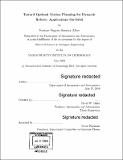| dc.contributor.advisor | David W. Miller. | en_US |
| dc.contributor.author | Albee, Keenan Eugene Sumner. | en_US |
| dc.contributor.other | Massachusetts Institute of Technology. Department of Aeronautics and Astronautics. | en_US |
| dc.date.accessioned | 2019-10-04T21:32:43Z | |
| dc.date.available | 2019-10-04T21:32:43Z | |
| dc.date.copyright | 2019 | en_US |
| dc.date.issued | 2019 | en_US |
| dc.identifier.uri | https://hdl.handle.net/1721.1/122405 | |
| dc.description | Thesis: S.M. in Aerospace Engineering, Massachusetts Institute of Technology, Department of Aeronautics and Astronautics, 2019 | en_US |
| dc.description | Cataloged from PDF version of thesis. | en_US |
| dc.description | Includes bibliographical references (pages 129-134). | en_US |
| dc.description.abstract | Robotic motion planning is a well-studied field at the intersection of optimal control, artificial intelligence, and applied mechanics. Methods for robots without dynamics are well-studied and are often practical for real-time deployment on current systems. However, robots that have dynamics, operate with uncertainty, or navigate difficult environments are at the edge of what is deployable today. While one may be able to develop a kinematic trajectory for a stationary fully-actuated robotic manipulator with modest degrees of freedom, developing strategies for underactuated systems of nearly any dimensionality remains a formidable challenge. This thesis addresses two primary corners of this problem, with specific focus on a use case of microgravity robotics: (1) how can one develop trajectories-ideally optimally and in real-time--for systems with high dimensionality and challenging environmental/dynamical constraints and (2) how can uncertain parameters be dealt with explicitly via motion planning. These methods are placed in context with discussion of the on-orbit assembly and servicing scenarios in which they might be used. A launch manifesting strategy for future missions requiring a large number of components on a mix of rockets is presented. These tools are a step in the direction of greater autonomy on-orbit, with wider applicability to robotic systems at large. | en_US |
| dc.description.statementofresponsibility | by Keenan Eugene Sumner Albee. | en_US |
| dc.format.extent | 134 pages | en_US |
| dc.language.iso | eng | en_US |
| dc.publisher | Massachusetts Institute of Technology | en_US |
| dc.rights | MIT theses are protected by copyright. They may be viewed, downloaded, or printed from this source but further reproduction or distribution in any format is prohibited without written permission. | en_US |
| dc.rights.uri | http://dspace.mit.edu/handle/1721.1/7582 | en_US |
| dc.subject | Aeronautics and Astronautics. | en_US |
| dc.title | Toward optimal motion planning for dynamic robots : applications on-orbit | en_US |
| dc.type | Thesis | en_US |
| dc.description.degree | S.M. in Aerospace Engineering | en_US |
| dc.contributor.department | Massachusetts Institute of Technology. Department of Aeronautics and Astronautics | en_US |
| dc.identifier.oclc | 1119723239 | en_US |
| dc.description.collection | S.M.inAerospaceEngineering Massachusetts Institute of Technology, Department of Aeronautics and Astronautics | en_US |
| dspace.imported | 2019-10-04T21:32:41Z | en_US |
| mit.thesis.degree | Master | en_US |
| mit.thesis.department | Aero | en_US |
